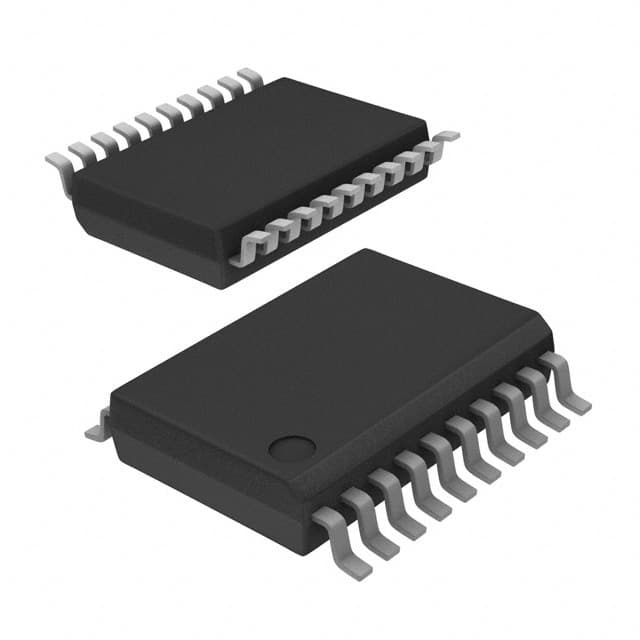74LVT241DB,118
Basic Information Overview
- Category: Integrated Circuit (IC)
- Use: Buffer/Line Driver
- Characteristics: Low Voltage, Tri-State Output, High-Speed Operation
- Package: SSOP-20
- Essence: Logic Level Translation and Signal Amplification
- Packaging/Quantity: Tape and Reel, 2500 pieces per reel
Specifications
- Supply Voltage: 1.2V to 3.6V
- Input Voltage: 0V to VCC
- Output Voltage: 0V to VCC
- Operating Temperature Range: -40°C to +85°C
- Propagation Delay Time: 4.5ns (max) at 3.3V supply voltage
- Output Current: ±24mA
- Input Capacitance: 3pF
- Output Capacitance: 6pF
Detailed Pin Configuration
The 74LVT241DB,118 IC has a total of 20 pins. The pin configuration is as follows:
___________
| |
1 |1 20| VCC
2 |2 19| A1
3 |3 18| OE#
4 |4 17| Y1
5 |5 16| GND
6 |6 15| Y2
7 |7 14| A2
8 |8 13| Y3
9 |9 12| OE#
10 |10 11| Y4
|___________|
Functional Features
- Tri-State Outputs: The IC provides tri-state outputs, allowing the user to disable the outputs when not needed.
- Logic Level Translation: It can translate logic levels between different voltage domains, making it suitable for interfacing between devices operating at different voltage levels.
- High-Speed Operation: The IC operates at high speeds, making it suitable for applications requiring fast signal transmission.
Advantages and Disadvantages
Advantages: - Low Voltage Operation: Can operate at low supply voltages, making it compatible with modern low-power systems. - Tri-State Outputs: Provides flexibility in controlling the output state. - High-Speed Operation: Enables fast data transmission.
Disadvantages: - Limited Output Current: The maximum output current is ±24mA, which may not be sufficient for certain applications requiring higher current drive.
Working Principles
The 74LVT241DB,118 is a buffer/line driver IC that amplifies and translates digital signals. It consists of four independent buffers with tri-state outputs. The inputs are TTL/CMOS compatible, and the outputs can drive both TTL and CMOS loads. The IC operates by receiving input signals, amplifying them, and providing the amplified signals at the outputs. The tri-state feature allows the user to disable the outputs when necessary.
Detailed Application Field Plans
The 74LVT241DB,118 IC finds applications in various fields, including: 1. Microcontroller Interfacing: It can be used to interface microcontrollers operating at different voltage levels. 2. Data Communication Systems: It is suitable for buffering and level translation in communication systems. 3. Industrial Automation: The IC can be utilized in industrial automation systems for signal amplification and translation. 4. Consumer Electronics: It can be employed in consumer electronic devices for level shifting and signal buffering.
Detailed and Complete Alternative Models
Some alternative models to the 74LVT241DB,118 IC include: - SN74LVC1G241DBVR - MC74VHC1G241DTT1G - 74LVC1G241GW,125
These alternative models offer similar functionality and can be used as replacements depending on specific requirements.
Word count: 345 words
Lista 10 Vanliga frågor och svar relaterade till tillämpningen av 74LVT241DB,118 i tekniska lösningar
Sure! Here are 10 common questions and answers related to the application of 74LVT241DB,118:
1. What is the function of the 74LVT241DB,118? The 74LVT241DB,118 is an octal buffer/line driver with 3-state outputs. It is used to amplify and buffer digital signals.
2. What is the voltage supply range for the 74LVT241DB,118? The voltage supply range for the 74LVT241DB,118 is typically between 2.7V and 3.6V.
3. How many inputs and outputs does the 74LVT241DB,118 have? The 74LVT241DB,118 has 8 inputs and 8 outputs.
4. Can the 74LVT241DB,118 be used in both TTL and CMOS applications? Yes, the 74LVT241DB,118 is compatible with both TTL and CMOS logic levels.
5. What is the maximum output current of the 74LVT241DB,118? The maximum output current of the 74LVT241DB,118 is typically 32mA.
6. Is the 74LVT241DB,118 capable of driving capacitive loads? Yes, the 74LVT241DB,118 can drive capacitive loads up to a certain limit specified in the datasheet.
7. Does the 74LVT241DB,118 have internal pull-up or pull-down resistors? No, the 74LVT241DB,118 does not have internal pull-up or pull-down resistors.
8. Can the 74LVT241DB,118 be used in high-speed applications? Yes, the 74LVT241DB,118 is designed for high-speed operation and can be used in such applications.
9. What is the propagation delay of the 74LVT241DB,118? The propagation delay of the 74LVT241DB,118 is typically around 4.5ns.
10. Can the 74LVT241DB,118 be cascaded to increase the number of outputs? Yes, multiple 74LVT241DB,118 chips can be cascaded together to increase the number of outputs in a system.
Please note that these answers are general and may vary depending on the specific datasheet and manufacturer's specifications for the 74LVT241DB,118.


